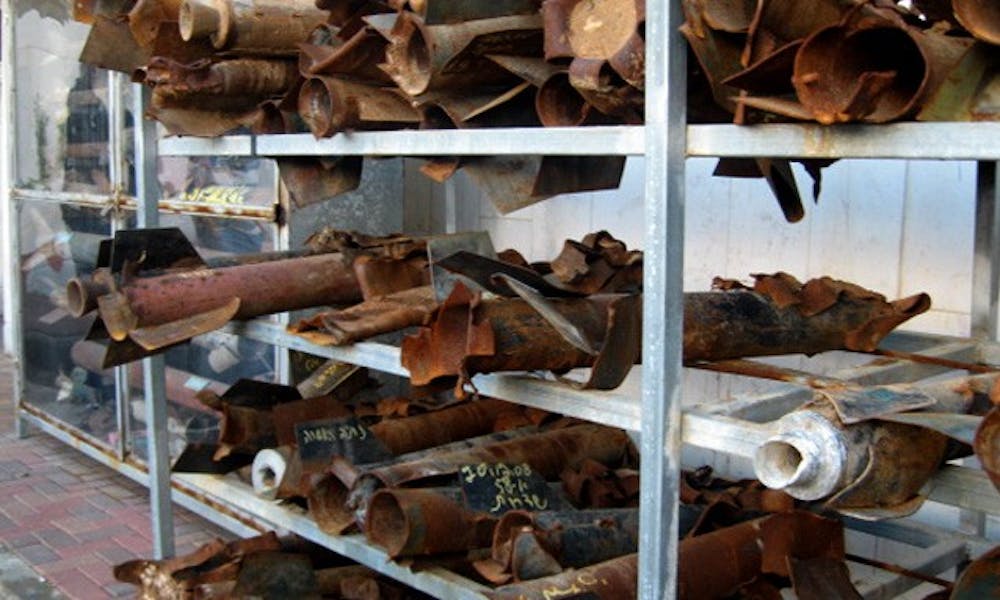The Chronicle’s Sabrina Rubakovic was part of a week-long trip to Israel with Project Interchange, an institute of the American Jewish Committee. She was one of many representatives from American campus newspapers visiting the Middle Eastern country to broaden perspectives of the region and explore Israeli-American relations. Rubakovic blogged daily about her experience.
I began 2010 in a pretty unique way—riding a camel in a Bedouin camp.
I was in Israel for New Year’s, participating in a week-long journalism seminar hosted by Project Interchange, an institute of the American Jewish Committee. The program was aimed at providing a first-hand experience of Israeli life and culture, Israel’s role in contemporary politics and the differing viewpoints on the Israeli-Palestinian conflict. For one amazing week, I traveled around Israel as part of a group of 17 college journalists looking to do something different for winter break and learn a few things along the way.
We spoke with government officials, academics, religious leaders, civilians, army soldiers and university students just like us about topics ranging from religious freedom in Israel to the Israeli-Palestinian conflict to nightlife in Tel Aviv. We met with conservatives, liberals, Israelis and Palestinians.
And the consensus on the issues was? Nada.
Almost every individual provided us with different information and different perspectives than the last.
But I think that hearing so many viewpoints about different issues gave me a broader perspective on Middle Eastern affairs. I left home on El Al flight 001 feeling as if I had a better grasp of concepts that I had only faintly understood from reading newspaper articles.
The seminar used a “real-time” approach: we were able to talk about important issues such as the Israeli-Palestinian conflict as they were going on.
We saw the remains of hundreds of rockets fired from the Gaza Strip into Israel that were salvaged by the security office in Sderot, a town close to the border with Gaza.
We had lunch at the home of Bob Lang, an Israeli settler living in the West Bank, a little more than a month after Israeli Prime Minister Benjamin Netanyahu called for a temporary freeze on some settlement construction. Lang pointed out the hilltops across from his house that could not be developed because of this freeze. From the window of his dining room, we saw an Arab town across from the settlement, providing a visual of the conflict that has encompassed Israeli and Palestinian life.
Actually, I take that back.
One of the points emphasized by many during the seminar was the fact that the Israeli-Palestinian conflict is not the huge part of life that it is often made out to be. A student at Tel Aviv University noted that many foreigners think that Israel is a war-torn desert full of refugees and soldiers.
Whatever similar pictures we had of Israel were quickly dismantled as we learned that Israeli life was startlingly normal. Tel Aviv is known as the New York City of Israel, a youth capital home to a bustling nightlife. One of Israel’s most popular shows is “Survivor,” a speaker noted, and a hotel we stayed in featured MTV shows like “My Super Sweet 16” and “Made” on its TVs (hopefully Israelis won’t see these as examples of normal American life).
On an academic level, Professor Yossi Shain of Tel Aviv University and Georgetown University told us that Israelis are unique in seeking normality in the midst of abnormality. Throughout an intense conflict, Shain said, Israelis looked to the future and contemplated how they can live a normal life.
In fact, a lot of Israel seemed just like any other country, aside from the subtle reminders of a deeply set conflict.
Driving through the town of Sderot, children played in a park that seemed like any other except that it contained a bomb shelter painted like a caterpillar. On the horizon, a bomb alert tower was visible.
The Tel Aviv University students seemed more passionate about their cause—finding peace—than activist college students in America. The military service required for most men and women prior to attending university lent a greater sense of maturity to many college students.
Just outside the West Bank, a highway in the town of Tzur Hadassah had a wall built into the side to shield passing cars from incoming gunshots.
And among this evidence of conflict and violence, Israelis carry a strong sense of national pride. This is largely embodied in Israel’s enormous immigrant population that is still growing rapidly every year. People of Jewish heritage from all around the world file into Israel to reconnect with their Jewish roots and make aliyah, or ascension upward, into their homeland.
That was certainly one of the many reasons young adults from all around the world came to Kvutzat Yavne, a kibbutz in central Israel. In this socialist-style living community, I met three teenagers from the United States, England and France. They were studying Hebrew intensely through the “5-5-5 approach”—five months, five days a week, five hours a day.
Get The Chronicle straight to your inbox
Sign up for our weekly newsletter. Cancel at any time.
As American college journalists, maybe we will never understand why those three teenagers left their lives back home to live in a kibbutz. Or why people are drawn to settle in the West Bank even if such settlement is causing enormous violence and conflict. Or even why so many civilians continue to live in Sderot even though it’s frequently subject to rocket fire from Gaza.
For how can a group of westernized foreigners comprehend religious ties and territorial claims that have spanned millennia? What we can do is open our eyes to cultures and viewpoints different from ours and experience them firsthand.
Read more about Sabrina’s trip to Israel online at
.

